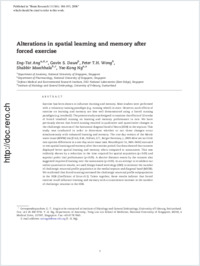Alterations in spatial learning and memory after forced exercise
- Ang, Eng-Tat Department of Anatomy, National University of Singapore, Singapore - Institute of Histology and General Embryology, University of Fribourg, Switzerland
- Dawe, Gavin S. Department of Pharmacology, National University of Singapore, Singapore
- Wong, Peter T.H. Department of Pharmacology, National University of Singapore, Singapore
- Moochhala, Shabbir Department of Pharmacology, National University of Singapore, Singapore - Defence Medical and Environmental Research Institute, DSO National Laboratories (Kent Ridge), Singapore
- Ng, Yee-Kong Department of Anatomy, National University of Singapore, Singapore
-
10.08.2006
Published in:
- Brain Research. - 2006, vol. 1113, no. 6, p. 186-193
English
Exercise has been shown to influence learning and memory. Most studies were performed with a voluntary running paradigm (e.g. running wheel) in mice. However, such effects of exercise on learning and memory are less well demonstrated using a forced running paradigm (e.g. treadmill). The present study was designed to examine the effects of 12 weeks of forced treadmill running on learning and memory performance in rats. We have previously shown that forced running resulted in qualitative and quantitative changes in the cholinergic neurons of the horizontal diagonal band of Broca (HDB) in the septum. This study was conducted in order to determine whether or not these changes occur simultaneously with enhanced learning and memory. The one-day version of the Morris water maze (MWM) test [Frick, K.M., Stillner, E.T., Berger-Sweeney, J., 2000. Mice are not little rats: species differences in a one-day water maze task. NeuroReport 11, 3461–3465] was used to test spatial learning and memory after the exercise period. Our data showed that runners displayed better spatial learning and memory when compared to nonrunners. This was evidently shown by a reduction in the time required for spatial acquisition (p < 0.05) and superior probe trial performance (p < 0.05). A shorter distance swam by the runners also suggested improved learning over the nonrunners (p < 0.05). In an attempt to revalidate our earlier quantitative results, we used design-based stereology (DBS) to estimate the number of cholinergic neuronal profile population in the medial septum and diagonal band (MSDB). We confirmed that forced running increased the cholinergic neuronal profile subpopulation in the HDB (Coefficient of Error < 0.2). Taken together, these results indicate that forced exercise could influence learning and memory with a concomitant increase in the number of cholinergic neurons in the HDB.
- Faculty
- Faculté des sciences et de médecine
- Department
- Département de Médecine
- Language
-
- English
- Classification
- Medicine
- License
- License undefined
- Identifiers
-
- RERO DOC 7850
- DOI 10.1016/j.brainres.2006.07.023
- Persistent URL
- https://folia.unifr.ch/unifr/documents/300356
Statistics
Document views: 107
File downloads:
- ang_asl.pdf: 245
